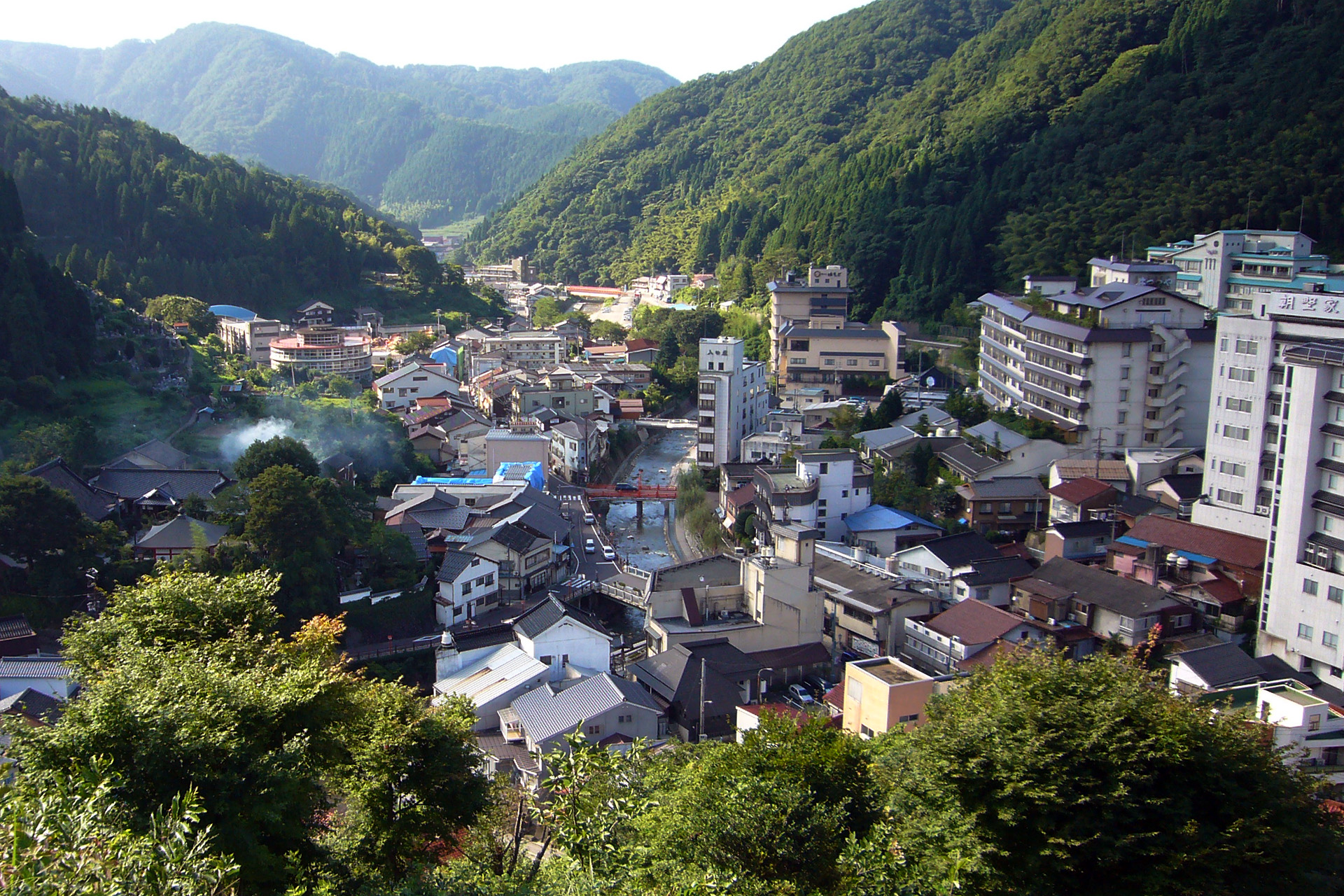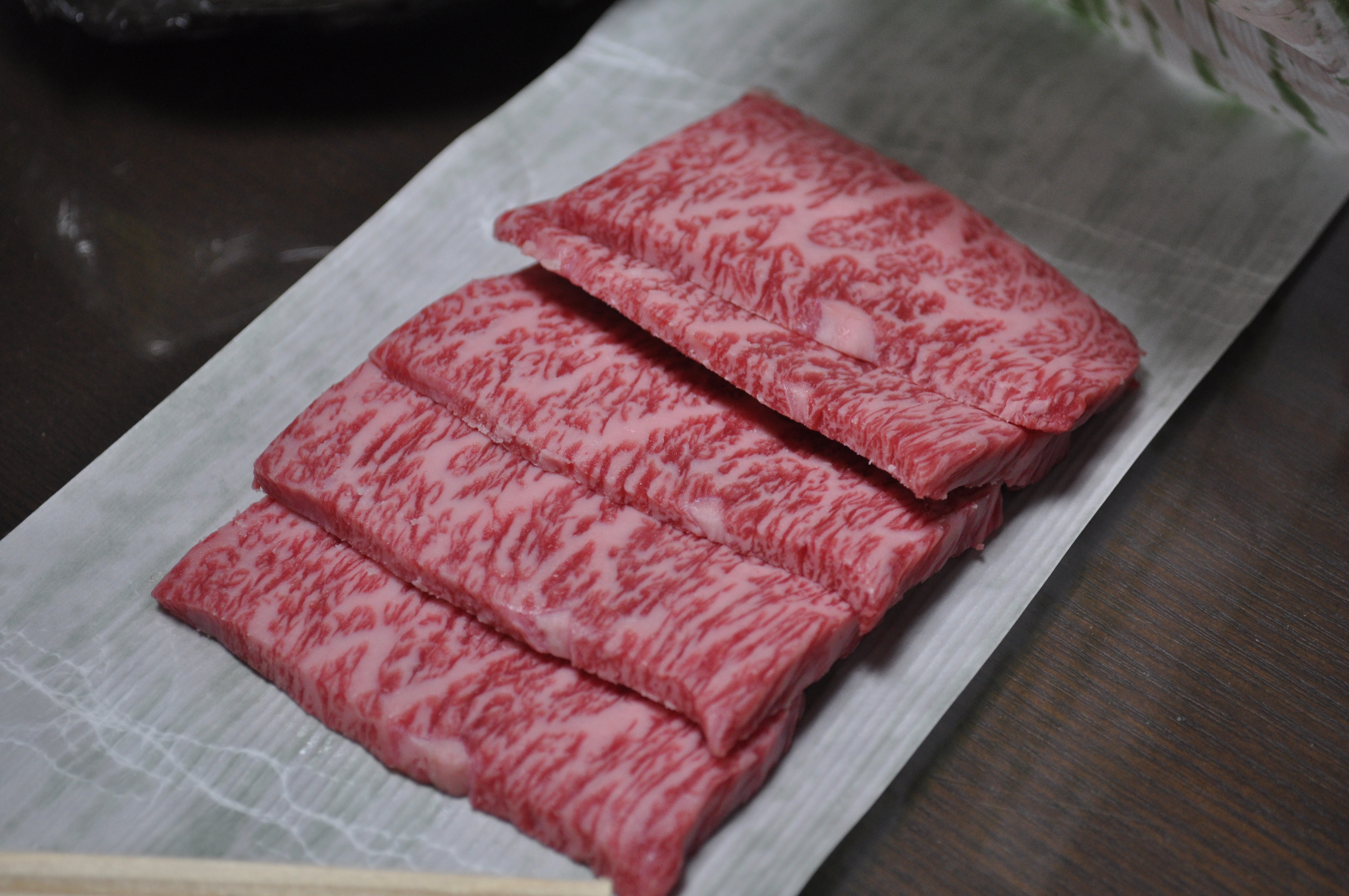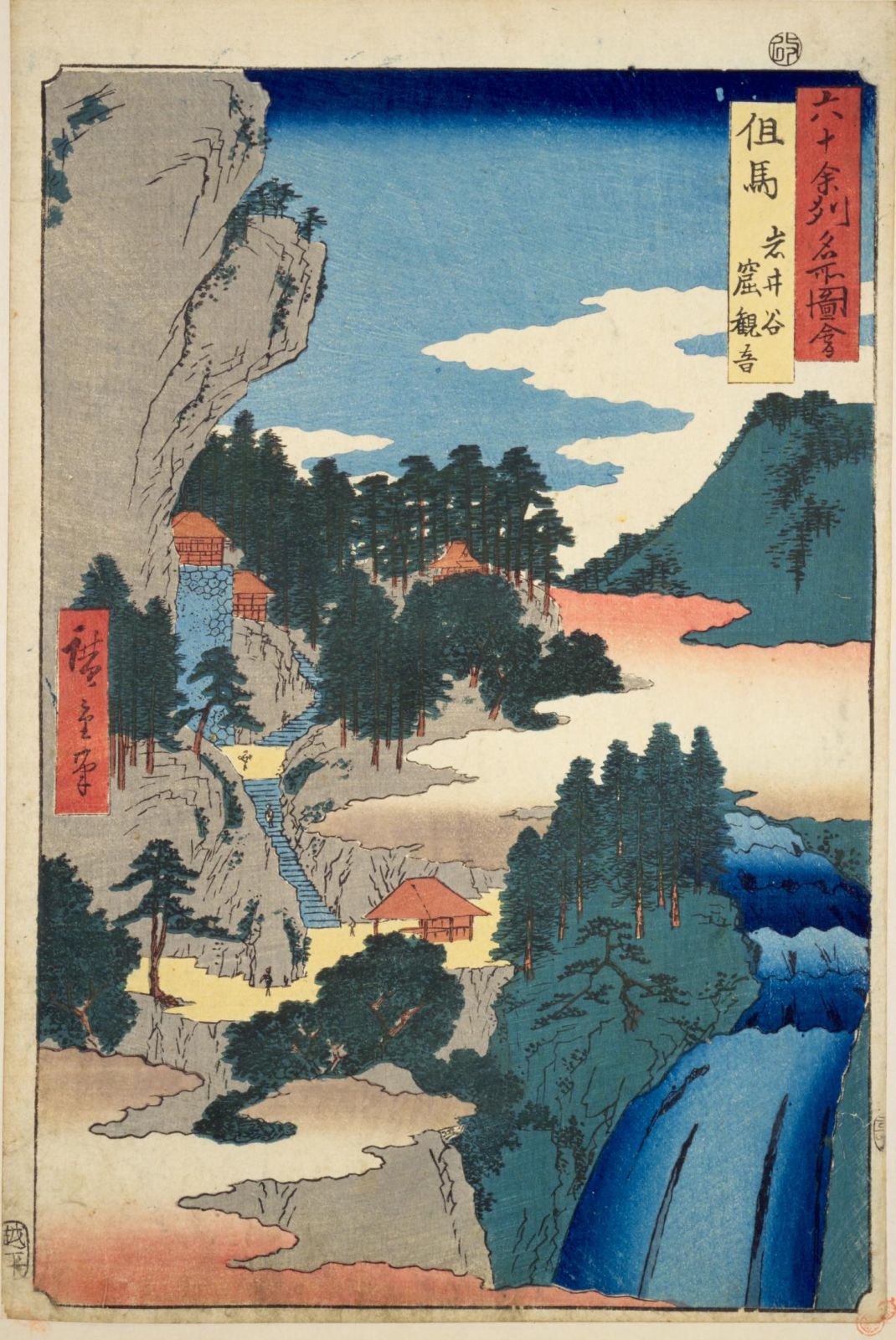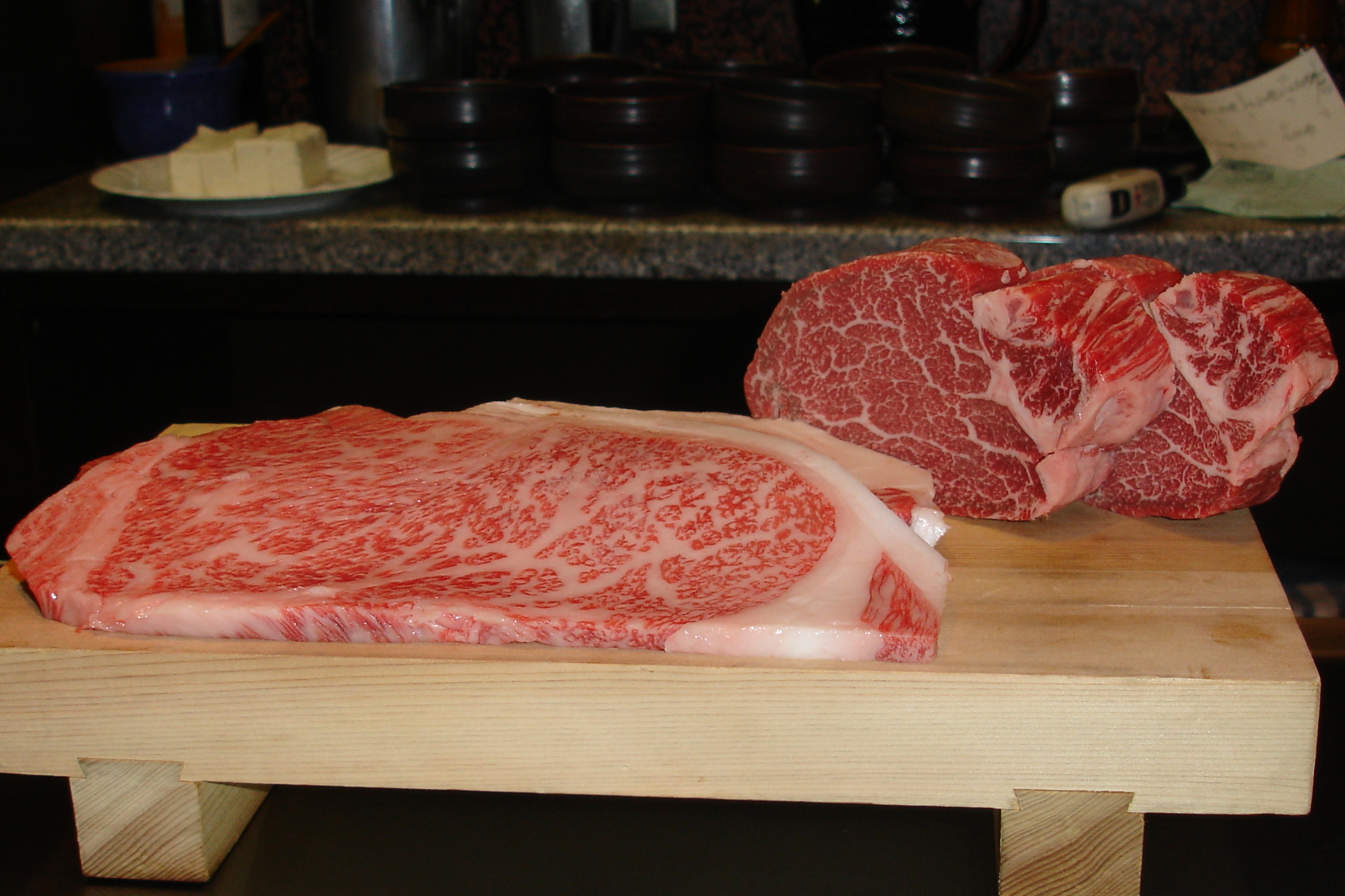|
Yumura Onsen (Hyogo)
Yumura Onsen (湯村温泉) is a small village located in Shin'onsen town in Mikata District, Hyōgo Prefecture, Japan. As of 2011, Yumura township had a population of 1,206, and its surrounding area (known as Onsen) had a total population of 6,454. Local legend states that the town’s hot springs (onsen) were uncovered in AD848 by the priest Jikaku Daishi. The town is said to have been inhabited since this time, and the local temple is claimed to have been built soon after the discovery of the hot springs. Here is one of the major geosites of San'in Kaigan Global Geopark. Climate Like most towns in northern Hyogo Prefecture, Yumura experiences disparate seasonal weather. Summers are typically very hot and humid (with an average daily high of 23.3 °C), while winter brings cold temperatures (an average daily high of 5.3 °C) and much snow. Hot springs The name 'Yumura' literally means 'hot spring village', and the hot springs play an important role in the tow ... [...More Info...] [...Related Items...] OR: [Wikipedia] [Google] [Baidu] |
Hiroshima
is the capital of Hiroshima Prefecture in Japan. , the city had an estimated population of 1,199,391. The gross domestic product (GDP) in Greater Hiroshima, Hiroshima Urban Employment Area, was US$61.3 billion as of 2010. Kazumi Matsui has been the city's mayor since April 2011. Hiroshima was founded in 1589 as a castle town on the Ōta River delta. Following the Meiji Restoration in 1868, Hiroshima rapidly transformed into a major urban center and industrial hub. In 1889, Hiroshima officially gained city status. The city was a center of military activities during the imperial era, playing significant roles such as in the First Sino-Japanese War, the Russo-Japanese War, and the two world wars. Hiroshima was the first military target of a nuclear weapon in human history. This occurred on August 6, 1945, at 8:15 a.m., when the United States Army Air Forces (USAAF) dropped the atomic bomb "Little Boy" on the city. Most of Hiroshima was destroyed, and by the end of th ... [...More Info...] [...Related Items...] OR: [Wikipedia] [Google] [Baidu] |
Spa Towns In Japan
A spa is a location where mineral-rich spring water (and sometimes seawater) is used to give medicinal baths. Spa towns or spa resorts (including hot springs resorts) typically offer various health treatments, which are also known as balneotherapy. The belief in the curative powers of mineral waters goes back to prehistoric times. Such practices have been popular worldwide, but are especially widespread in Europe and Japan. Day spas and medspas are also quite popular, and offer various personal care treatments. Origins of the term The term is derived from the name of the town of Spa, Belgium, whose name is known from Roman times, when the location was called ''Aquae Spadanae'', sometimes incorrectly connected to the Latin word ''spargere'' meaning to scatter, sprinkle or moisten. Since medieval times, illnesses caused by iron deficiency were treated by drinking chalybeate (iron-bearing) spring water (in 1326, the iron-master Collin le Loup claimed a cure,Medical Hydrology, Si ... [...More Info...] [...Related Items...] OR: [Wikipedia] [Google] [Baidu] |
Tourist Attractions In Hyōgo Prefecture
Tourism is travel for pleasure or business; also the theory and practice of touring (other), touring, the business of attracting, accommodating, and entertaining tourists, and the business of operating tour (other), tours. The World Tourism Organization defines tourism more generally, in terms which go "beyond the common perception of tourism as being limited to holiday activity only", as people "travelling to and staying in places outside their usual environment for not more than one consecutive year for leisure and not less than 24 hours, business and other purposes". Tourism can be Domestic tourism, domestic (within the traveller's own country) or International tourism, international, and international tourism has both incoming and outgoing implications on a country's balance of payments. Tourism numbers declined as a result of a strong economic slowdown (the late-2000s recession) between the second half of 2008 and the end of 2009, and in consequence of t ... [...More Info...] [...Related Items...] OR: [Wikipedia] [Google] [Baidu] |
Sparkling Enope Squid
The firefly squid (''Watasenia scintillans''), also commonly known as the sparkling enope squid or hotaru-ika in Japan, is a species of squid in the family Enoploteuthidae. It is the sole species in the monotypic genus ''Watasenia''. These tiny squid are found on the shores of Japan in springtime during spawning season, but spend most of their lives in deeper waters between . They are bioluminescent organisms and emit blue light from photophores, which some scientists have hypothesized could be used for communication, camouflage, or attracting food, but it is still unclear in the scientific community exactly how this species uses their bioluminescence. The firefly squid is a predator and actively hunts its food, which includes copepods, small fish, and other squids. The lifespan of a firefly squid is about one year. At the end of their lives females return close to shore to release their eggs, and then die shortly thereafter. This mass migration of firefly squid to the shore is a ... [...More Info...] [...Related Items...] OR: [Wikipedia] [Google] [Baidu] |
Chionoecetes
''Chionoecetes'' is a genus of crabs that live in the northern Pacific and Atlantic Oceans. The genus ''Chionoecetes'' currently contains seven distinct species. Other names for crabs in this genus include "queen crab" (in Canada) and "spider crab" – they are known by different names in different areas of the world. The generic name ''Chionoecetes'' means snow (, ') inhabitant (, '); ' means shepherd, and '' C. opilio'' is the primary species referred to as snow crab. Marketing strategies, however, employ snow crab for any species in the genus ''Chionoecetes''. The name "snow crab" refers to their being commonly found in cold northern oceans. General Snow crab are caught as far north as the Arctic Ocean, from Newfoundland to Greenland and north of Norway in the Atlantic Ocean, and across the Pacific Ocean, including the Sea of Japan, the Bering Sea, the Gulf of Alaska, Norton Sound, and even as far south as California for ''Chionoecetes bairdi''. In 2019 the Norwegian Supre ... [...More Info...] [...Related Items...] OR: [Wikipedia] [Google] [Baidu] |
Matsusaka Beef
is the meat of Japanese Black cattle reared under strict conditions in the Matsusaka region of Mie in Japan. It has a high fat-to-meat ratio. Within Japan, it is one of the three ''Sandai Wagyū'', the "three big beefs"; the others are Kobe beef and Ōmi beef or Yonezawa beef. About 2500 cows are slaughtered for Matsusaka beef each year; the meat commands high prices. History Before the 19th century, beef was not typically a part of the average Japanese diet. Farmers in the Mie Prefecture would raise smaller and more muscular, female cows to do agricultural work. When westerners introduced them to eating beef, farmers began to raise the cows to have traits that were more favorable for human consumption. The "National Beef Exposition" awarded Matsusaka with the medal of high honor in 1938. The award helped make Matsusaka more well known. The beef became famous for its marbling, rich flavor, and tenderness. Original standards The cows take roughly three years to mature. [...More Info...] [...Related Items...] OR: [Wikipedia] [Google] [Baidu] |
Tajima Province
was a province of Japan in the area of northern Hyōgo Prefecture. Tajima bordered on Tango and Tanba to the east, Harima to the south, and Inaba to the west. Its abbreviated form name was . In terms of the Gokishichidō system, Tajimao was one of the provinces of the San'indō circuit. Under the ''Engishiki'' classification system, Tajima was ranked as one of the "superior countries" (上国) in terms of importance, and one of the "near countries" (近国) in terms of distance from the capital. The provincial capital was located in what is now the city of Toyooka. The ''ichinomiya'' of the province is the Izushi Shrine also located in Toyooka. The area of the province was 2099.01 square kilometers. History Early history The early history of the Tajima region is uncertain. There appear to have been two power centers. The Tajima ''Kuni no miyatsuko'' ruled in eastern Tajima (present-day Asago District and Yabu District) and are mentioned in the ''Kujiki''. They tenuously ... [...More Info...] [...Related Items...] OR: [Wikipedia] [Google] [Baidu] |
Kobe Beef
is Wagyu beef from the Tajima strain of Japanese Black cattle, raised in Japan's Hyōgo Prefecture according to rules set out by the Kobe Beef Marketing and Distribution Promotion Association. The meat is a delicacy, valued for its flavor, tenderness, and fatty, well- marbled texture. Kobe beef can be prepared as steak, '' sukiyaki'', ''shabu-shabu'', ''sashimi'', and ''teppanyaki''. Kobe beef is generally considered one of the three top brands (known as Sandai Wagyu, "the three big beefs"), along with Matsusaka beef and Ōmi beef or Yonezawa beef. Kobe beef is also called , ''Kōbe-gyū'' or in Japanese. History Cattle were brought to Japan from China in about the second century AD, in the Yayoi period. Until about the time of the Meiji Restoration in 1868, they were used only as draught animals, in agriculture, forestry, mining and for transport, and as a source of fertiliser. Milk consumption was unknown, and – for cultural and religious reasons – meat was not ... [...More Info...] [...Related Items...] OR: [Wikipedia] [Google] [Baidu] |
Tajima Cattle
The Japanese Black ( ja, 黒毛和種, Kuroge Washu) is a breed of Japanese beef cattle. It is one of six native Japanese cattle breeds, and one of the four Japanese breeds known as wagyū, the others being the Japanese Brown, the Japanese Polled and the Japanese Shorthorn. All wagyū cattle derive from cross-breeding in the early twentieth century of native Japanese cattle with imported stock, mostly from Europe. In the case of the Japanese Black, the foreign influence was from European breeds including Braunvieh, Shorthorn, Devon, Simmental, Ayrshire and Holstein. History Cattle were brought to Japan from China at the same time as the cultivation of rice, in about the second century AD, in the Yayoi period. Until about the time of the Meiji Restoration in 1868, they were used only as draught animals, in agriculture, forestry, mining and for transport, and as a source of fertiliser. Milk consumption was unknown, and – for cultural and religious reasons – meat was not eaten ... [...More Info...] [...Related Items...] OR: [Wikipedia] [Google] [Baidu] |
Sanin Kaigan National Park
is a National Park in the Tottori, Hyōgo, and Kyōto Prefectures, Japan. Established in 1963, the park runs continuously along the Sea of Japan coast from Tottori to Kyōtango. The park covers 87.83 km². Sanin Kaigan National Park is known for its numerous inlets, rock formations, islands, and caves. The entire area of this national park is a part of San'in Kaigan Global Geopark. Sites of interest * * * * *Tottori Sand Dunes * Noted fauna and flora *''Pinus thunbergii'', the Japanese black pine * Japanese martin * Black-tailed gull Related municipalities * Kyōto: Kyōtango * Hyōgo: Kami, Shin'onsen, Toyooka * Tottori: Iwami, Tottori See also * List of national parks of Japan * Wakasa Wan Quasi-National Park * Tourism in Japan Japan attracted 31.88 million international tourists in 2019. Japan has 21 World Heritage Sites, including Himeji Castle, Historic Monuments of Ancient Kyoto and Nara. Popular foreigner attractions include Tokyo and Hir ... [...More Info...] [...Related Items...] OR: [Wikipedia] [Google] [Baidu] |
Thousand Origami Cranes
The crane in Japan is one of the mystical or holy creatures (others include the dragon and the tortoise) and is said to live for a thousand years: That is why cranes are made, one for each year. In some stories it is believed that the 1000 cranes must be completed within one year and they must all be made by the person (or group of people) who will make the wish at the end. Cultural significance In Japan cranes have been thought a symbol of long life. An old fix phrases says "cranes live a thousand years". Here "a thousand" is not necessary to designate the exact number, but a poetic expression of huge amounts. Historically well-wishers offered a picture of a crane to shrines and temples as well as paper cranes. Origami, specially crafted and pattern-printed paper was invented in Edo period, and in the late 17th century books referring not only to "paper cranes" but also to "one thousand cranes" were publish Nowadays cranes are often given to a person who is seriously ill, ... [...More Info...] [...Related Items...] OR: [Wikipedia] [Google] [Baidu] |










